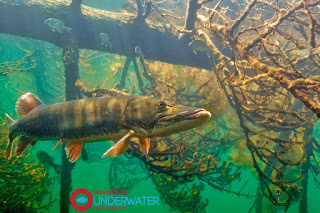Imagine you’ve invited some friends over for dinner. You spend all afternoon preparing and cooking a well-planned meal. After your guests finish eating, they enthusiastically proclaim it be one of the best meals they’ve ever eaten. Then they ask “What kind of stove did you use?” In this context, it would be a nonsensical question that no one would ever ask. But as a photographer, I’m very frequently asked what kind of camera I use when well-meaning admirers view my underwater images.
The implication is that all the magic happens inside the
camera, and the photographer is merely the lever puller who simply manipulates
the marvelous technology that’s really responsible for creating the magical
images. To ask photographers what kind
of camera equipment they use is as meaningless as asking a chef what kind of
stove he uses. The question usually
comes from novice photographers who are looking for a shortcut to propel their
own photography to a higher level. It may seem like an innocent and not
irrelevant question, but it fails to identify the secret that’s the real
foundation of stunning images.
Thirty years ago when I first began taking underwater
pictures, I was consumed by the same quest. If I could just find a great
underwater camera, I’d be able to take pictures for National Geographic just
like the pros did. Every few years I would buy a better camera, a faster lens
or a more durable housing. While that
did make a difference in the quality of the pictures I took, something was
missing that took me years to detect. In my case, with underwater photography,
I had some of the best equipment I could afford, but what was lacking was
sufficient knowledge of my subjects.
This wasn’t something I was aware of decades ago. Instead, it
was a shortcoming that has only revealed itself in retrospect. Over time, as I
learned more about the lives of the fish I was photographing, my images of them
became more appealing and more penetrating. I began to study their behavior and
their body language and I began to notice how my own body language, movements, and
behavior affected them. In time, a kind of communication developed. I became
able to recognize subtle cues from timid fish and learned how to approach them
in non-threatening ways. I also learned how to send out my own signals which
fish could decipher that would put them at ease.
My office bookshelves that were once filled with
photography books began to be populated with books about fish and fish biology.
As I learned more and more about my subjects, not only did my appreciation and
knowledge for them grow, but my photography of them improved dramatically.
Reading about fish was invaluable, but my real education
came from the fish themselves. As I spent more and more time underwater
observing and interacting with them, they divulged more and more about
themselves. Over time and one by one, all their habits, routines, and
individualities that weren’t discussed in fish books were revealed like a
cascade of unmasked secrets. I make no apologies for anthropomorphizing fish
when I talk about their personalities. When you’ve spent as much time with them
in their underwater habitats as I have, these conclusions feel not only
justified but undeniable.
Today, when young photographers ask me what kind of camera I
use, I ignore the question entirely and instead encourage them to learn all
they can about their subjects. In all
areas of wildlife photography, if you fall in love with your subjects and let
them teach you, it will be impossible for your images to not mirror that love and
appreciation. And I think that single element, one that admittedly can’t be
quantified precisely, is what makes a captivating image.





























